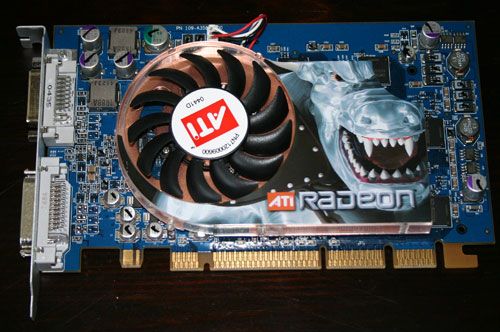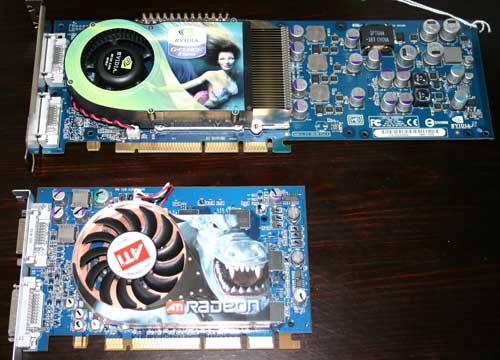ATI Radeon X800 XT Mac Edition: Competition in the Mac Market
by Anand Lal Shimpi on January 5, 2005 7:38 PM EST- Posted in
- Mac
In the PC world, ATI and NVIDIA duke it out every 6 months for retail sales and OEM customers. The Mac world is a little different, without tons of OEMs and a very small retail market, the ATI/NVIDIA battle is considerably less heated.
Apple, being the largest customer for Mac video cards, causes things to work a bit differently. While priding themselves on being quite secretive about future product plans, Apple does routinely share bits and pieces of their roadmaps with ATI and NVIDIA – detailing their graphics card needs for future notebooks and desktops. ATI and NVIDIA, in turn, pitch to Apple their forthcoming GPUs that would potentially meet the requirements of Apple’s roadmap.
Apple then decides which GPUs they want to use based on a variety of factors including, but not limited to, feature set, performance and price point. Apple also does their best to strike a balance between ATI and NVIDIA, so they never overly support one manufacturer over another.
Most recently the flagship GPU for Apple’s G5 line was ATI’s Radeon 9800 Pro Mac Special Edition, which was then replaced by NVIDIA’s GeForce 6800 Ultra DDL. Today, ATI is releasing into retail the first alternative to the GeForce 6800 Ultra DDL – the Radeon X800 XT Mac Edition.

Priced at $499, the 256MB X800 XT Mac Edition is a lower clocked version of the PC X800 XT. While the PC X800 XT runs at a 500MHz core clock with 1GHz memory, the X800 XT Mac Edition runs at a 475MHz core clock while keeping the same memory clock. The reason behind the lower core clock speed is simple, ATI’s not making a whole lot of X800 XT Mac Edition boards, so they want to make sure they are as high yielding as possible. In order to meet the $499 price point they had to slightly lower the core clock speed. We did promptly inform ATI that Mac folks don’t like their cards to be clocked lower than the PC equivalents but given the small clock difference, we’d much rather have a cheaper card.
Architecturally, the X800 XT Mac Edition is identical to the PC version (much like the 6800 Ultra DDL is architecturally identical to the PC version). For a better understanding of the architecture of the X800 XT Mac Edition and how it compares to the 6800 Ultra DDL please visit our original X800 article. Although it was reviewed from a PC perspective, the background architectural information remains the same.
The X800 XT Mac Edition is an AGP Pro 8X card (thus requires no external power), with one powered ADC port and one dual-link DVI port, the latter which is capable of driving the new 30” Cinema Display. The card uses the same cooling solution as the PC X800 XT, and ends up producing just as much noise as the GeForce 6800 Ultra DDL. Much like the PC version, the X800 XT is only a single slot, thus it leaves all of your PCI-X slots untouched.

NVIDIA's 6800 Ultra DDL is almost as long as Apple's keyboard
NVIDIA’s GeForce 6800 Ultra DDL on the other hand occupies two slots, and is significantly larger. On the flip side, the 6800 Ultra DDL is clocked at the same speeds as the PC 6800 Ultra, 400MHz core and 1.1GHz memory clock. The result is that the 6800 Ultra has a lower fill rate but more memory bandwidth than the X800 XT Mac Edition since they are both 16 pipe, 256-bit memory bus GPUs.

NVIDIA's GeForce 6800 Ultra DDL (top) vs. ATI's X800 XT Mac Edition (bottom)
While the GeForce 6800 Ultra DDL is priced at $599, NVIDIA also has a 6800GT DDL which runs at 350MHz core with 1GHz memory and is priced at $499. We weren’t able to secure a 6800GT DDL for testing today but we will be able to draw some conclusions based on the results today of how the X800 XT Mac Edition would stack up. In edition to the two new heavyweights we are also looking at the ATI Radeon 9800 Pro Mac Special Edition, ATI’s previous flagship part.










35 Comments
View All Comments
Dennis Travis - Thursday, January 6, 2005 - link
Very well done Anand. Thanks so much.I am told Doom III should be out sometime late January or early Feburary. Battlefield and Call of Duty have been out for a long time as well as The Sims and other games.
aliasfox - Thursday, January 6, 2005 - link
#12You may be able to flash the X800XT's firmware with PC firmware to get it to work, though as the cards are slightly different, I wouldn't guarantee it working. $500 is a lot to just try this out (and find out it doesn't work).
KirinRiotCrash - Thursday, January 6, 2005 - link
ProviaFan is right. The Mac versions of the ATI cards use a different BIOS so that they work with Macs. I would guess if you were to hook this up on a PC, you'd need to reflash it with your trusty set of BIOS hacking tools in order to make it work on the PC. I do know that in the Mac side, in order for a PC ATI card (and some nVidias, too)to work properly, it needs to be re-flashed first.ProviaFan - Thursday, January 6, 2005 - link
Aside from the ADC connector, I would suppose that these cards use different BIOSes from their PC counterparts - something that would make them incompatible even if everything else were identical.Poser - Thursday, January 6, 2005 - link
I'd also like to know what #9 asked - what would happen if you plugged one of these in a PC? What're the hardware diffences that make graphics cards incompatible?Poser - Thursday, January 6, 2005 - link
Speaking as someone who dislikes Apple, I still find these articles interesting. It's peering into niches which I'd otherwise never bother to look at, much like the reviews of high end workstations. In both cases, I can't see myself ever buying the products discussed, but there's always little tidbits that flesh out my understanding of computing in general - stuff like the paragraph on the TMDS links.Thanks for yet another well written article, Anand.
jeremyk44 - Thursday, January 6, 2005 - link
What about a consumer PC card that can run the 30 inch display? What would happen if you plugged the ATI card into a PCGooger - Wednesday, January 5, 2005 - link
#2 It's standard size for some Workstation Cards, and is within PCI Spec. You are just used to seeing 1/4 sized PCI cardsKirinRiotCrash - Wednesday, January 5, 2005 - link
As both a PC and a Mac user, I really do appreciate this kind of article posted on a PC-centric site. It doesn't look biased and it's rather professional. (Whether hardcore PC users appreciate these kind of Mac-based articles is another story).Although, I would agree that you should also include Motion benches there, too. Motion, I heard, is rather hard on the graphics card. Last I checked, a minimum of a Radeon 9500 is required.
OriginalReaper - Wednesday, January 5, 2005 - link
.01% of your readers thank you for this article